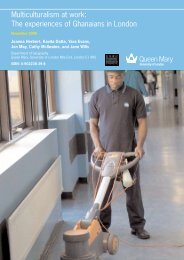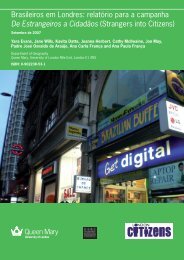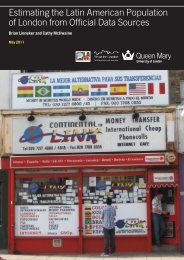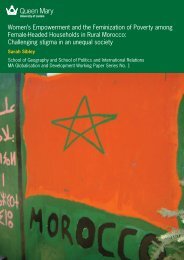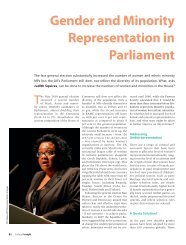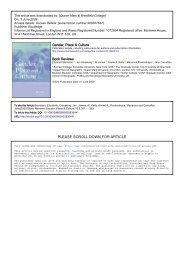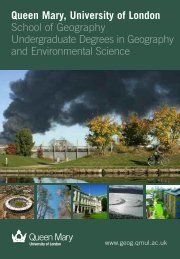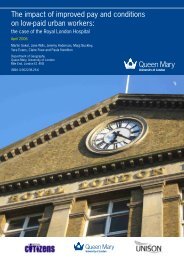The Colombian community in London - Geography - Queen Mary ...
The Colombian community in London - Geography - Queen Mary ...
The Colombian community in London - Geography - Queen Mary ...
- No tags were found...
Create successful ePaper yourself
Turn your PDF publications into a flip-book with our unique Google optimized e-Paper software.
McIlwa<strong>in</strong>e et al., 2011). This is the average for <strong>London</strong> as a whole (24%) (DCLG, 2009: 11),<br />
and reflects the fact that many <strong>Colombian</strong>s are well-established <strong>in</strong> the city and have<br />
permanent residency and citizenship. <strong>Colombian</strong> women were also much more likely to live <strong>in</strong><br />
social hous<strong>in</strong>g than men (42% compared with only 6%).<br />
Rates of owner occupation were also very low (see Table 4) and more people had a mortgage<br />
(10%) than owned outright (3%). This is much lower than the average owner-occupation<br />
(<strong>in</strong>clud<strong>in</strong>g those with a mortgage and own<strong>in</strong>g outright) for <strong>London</strong> as a whole (55%) (DCLG,<br />
2009: 11). Not surpris<strong>in</strong>gly, owner occupation was concentrated among those with British or<br />
EU citizenship and among professionals and managers.<br />
<strong>The</strong> proportions of <strong>Colombian</strong>s liv<strong>in</strong>g <strong>in</strong> temporary accommodation were comparatively low at<br />
2%, although this is the same as the <strong>London</strong> average (MacInnes and Kenway, 2009: 89) and<br />
the highest among all Lat<strong>in</strong> Americans. In addition, 1% of Lat<strong>in</strong> Americans were homeless,<br />
which is slightly higher than those newly recognised as homeless <strong>in</strong> <strong>London</strong> <strong>in</strong> 2007 (ibid.: 87).<br />
In addition, 26% of <strong>Colombian</strong>s shared their home with another family <strong>in</strong>dicat<strong>in</strong>g overcrowd<strong>in</strong>g<br />
(with an average of 2 other families). Although approximately 14% explicitly identified overcrowd<strong>in</strong>g<br />
as an issue, this is certa<strong>in</strong>ly an under-estimate. This was ma<strong>in</strong>ly because some<br />
people reported liv<strong>in</strong>g alone because they cooked alone or ma<strong>in</strong>ta<strong>in</strong>ed <strong>in</strong>dividual f<strong>in</strong>ances yet<br />
they lived <strong>in</strong> larger houses where, for example, the liv<strong>in</strong>g room was used as a bedroom or<br />
where several adults shared bedrooms (both <strong>in</strong>dicators of over-crowd<strong>in</strong>g). Even<br />
acknowledg<strong>in</strong>g this, the rate of 14% is high compared to <strong>London</strong> as a whole where 6.8% of<br />
households are overcrowded (DCLG, 2009: 12). 11 Overcrowded conditions are associated with<br />
low-skilled work and irregularity. For <strong>in</strong>stance, 39% of elementary workers shared their homes<br />
compared with 9% of professional and managerial workers. Men were more likely to be liv<strong>in</strong>g<br />
<strong>in</strong> hous<strong>in</strong>g with other families than women (32% and 20%).<br />
Household structures<br />
<strong>The</strong> mean household size among <strong>Colombian</strong>s was 2.7 with the largest household hav<strong>in</strong>g 7<br />
people. This is larger than the UK average of 2.4 persons <strong>in</strong> 2008 (DCLG, 2009: 12). It is also<br />
slightly larger than the local authority with the largest average size <strong>in</strong> England and Wales of<br />
2.64 – <strong>London</strong> Borough of Newham. 12<br />
Almost a quarter of <strong>Colombian</strong>s lived <strong>in</strong> couple households with no dependent children (24%)<br />
which is lower than the average of 35%. Another 22% lived <strong>in</strong> multi-person households, which<br />
is much higher than the population nationally (8%). 13 19% lived <strong>in</strong> couple households with<br />
dependent children, which is lower than the UK average of 28%. Another 22% were people<br />
liv<strong>in</strong>g alone which is lower than the national average of 29%. A further 13% lived <strong>in</strong> lone parent<br />
households, which is higher than the national average of 7% (see Figure 11) (DCLG, 2009:<br />
25).<br />
11 Other estimates suggest overcrowd<strong>in</strong>g to be 25% of households <strong>in</strong> Inner <strong>London</strong> and 13% <strong>in</strong> Outer<br />
<strong>London</strong> (MacInnes and Kenway, 2009: 92).<br />
12 Office of National Statistics. Available at<br />
http://www.statistics.gov.uk/census2001/profiles/commentaries/hous<strong>in</strong>g.asp (accessed 1st September<br />
2010).<br />
13 A multi-person household refers to „a group of two or more persons liv<strong>in</strong>g together who make<br />
common provision for food or other essentials for liv<strong>in</strong>g‟<br />
(http://unstats.un.org/unsd/demographic/products/dyb/techreport/hhChar.pdf (acessed 10 February<br />
2011). <strong>The</strong> def<strong>in</strong>ition used here also draws on that used <strong>in</strong> the English Hous<strong>in</strong>g Survey to <strong>in</strong>clude „flat<br />
sharers, lone parents with non-dependent children only and households conta<strong>in</strong><strong>in</strong>g more than one<br />
couple or lone parent family‟<br />
(http://www.communities.gov.uk/hous<strong>in</strong>g/hous<strong>in</strong>gresearch/hous<strong>in</strong>gsurveys/surveyofenglishhous<strong>in</strong>g/se<br />
hlivetables/surveyenglish/224421/ (accessed 10 February 2011)<br />
24



